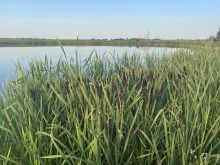Allergic reactions, respiratory diseases, ulcers and abortions are a
sample of the problems mouldy hay can cause in cattle herds.
The challenge for producers is knowing how to limit mould, especially
in years when wet weather arrives at haying time.
Karin Wittenberg, head of animal science at the University of Manitoba,
was recently in Brandon to outline options.
During the Manitoba Livestock Expo, she spoke about improved harvesting
equipment, but devoted most of her time to forage additives and drying
Read Also

Europe holds promise for Canadian lentils
Pulse Canada is trying to help boost lentil consumption in Europe, which is already the fourth largest market.
agents.
Wittenberg gave an overview of the three categories of forage
additives, and suggested that only one offers a reliable defence
against mould accumulation in hay.
Within that category are what she called the “true preservatives,”
namely products made from organic acids or antioxidants that have been
tested and proven to slow or stop mould growth.
Wittenberg listed six products registered and sold in Canada as true
preservatives for forages. However, they are not all available in
Manitoba. Two that are available are Hay Pro II and Bale Green.
She reminded producers who use organic acid-based preservatives that
they need the right balance of acid and water when treating forages.
For example, in a field where there is rolling terrain, hay in the
lower lying areas could have more moisture, prompting the need for a
more highly concentrated treatment.
“As the moisture content goes up, you have to be able to increase the
concentrations of the active ingredient.”
Greater concentrations of the active ingredient should also be
considered when there are weeds or stemmy alfalfa in the forage. Those
things can increase the hay’s moisture content, increasing the risk of
mould.
Companies making preservatives from organic acids are now leaning
toward the neutralized form. The concentrated forms are corrosive and
somewhat volatile, meaning they can be lost into the air after the
forage is treated.
There were also potential side effects to producers.
“I’m sure there are producers who no longer have their sense of smell
from only one exposure to the concentrated form,” Wittenberg said.
She categorized the two other treatment types as nutritive additives
and non-nutritive additives.
Nutritive additives, such as urea and molasses, are applied to increase
the nutritional value of the forage. Non-nutritive additives, such as
enzymes, yeasts and bacteria, are used mainly to reduce nutritional
losses during hay harvest and storage.
Products in those two categories may carry labels claiming that one of
their secondary benefits is mould reduction.
However, Wittenberg said that’s not the basis on which they were
registered and producers need to view those claims with a grain of salt.
Among the non-nutritive additives are bacteria-based inoculants. They
can work against mould, Wittenberg said, but the results aren’t
consistent.
“They tend to work on forage that has not had rain or heavy dew on it.”
With drying agents, Wittenberg said there is only one option available
to Manitoba forage producers. That’s potassium carbonate and it’s
limited to use only on legumes.
Potassium carbonate is applied when the crop is cut and works by
breaking up the cuticles on the stems of the plant, allowing moisture
to escape faster.
That option can work well in dry harvesting weather, but may backfire
if rainy weather moves in or there is a stretch of days with heavy dew.
With the cuticles disrupted, the hay could absorb moisture.
Mouldy hay can cause abortions in pregnant cattle. Mould can also cause
respiratory problems, but they can be reduced if cattle are fed
outside, she said.
Mouldy hay can also turn cattle off their feed, leading to poorer herd
performance.
However, Wittenberg said high fibre levels in forage can depress a
cow’s appetite even more than mould. High fibre usually occurs when a
forage crop is harvested after it has reached full maturity, resulting
in coarse stems and less leafy material.
Wittenberg also said moisture testing and hay conditioners are valuable
tools when trying to limit mould levels in forages.














